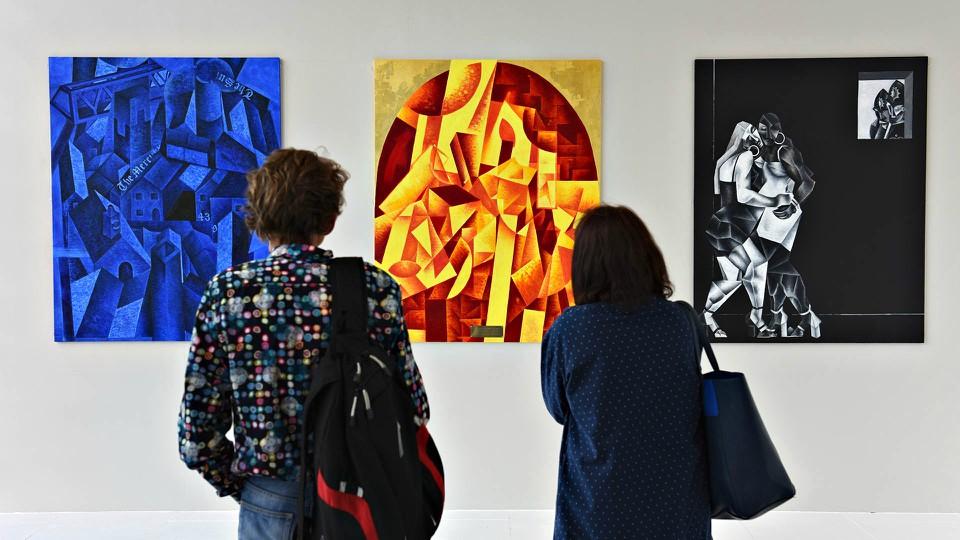Remembering the New Cross Fire
Primary page content
Thursday 18 January 2018 represents 37 years since the infamous New Cross Fire, in which 13 young black men and women were killed in a suspected racially motivated arson attack at a house party.

'Now and Then, Here and There' Ella Jones-Moore
Goldsmiths MFA Fine Art student, Ella Jones, used the event as motivation for her 2017 BA Fine Art Degree Show project ‘Now and Then, Here and There’.
The triptych of paintings is being displayed in the Kingsway Corridor in the Richard Hoggart Building to mark the anniversary. I spoke to Ella about the project and the significance of the fire.
Chris Smith: Why did you choose to address the New Cross Fire in this piece?
Ella Jones: Having been born, raised and educated in Lewisham, a historically working-class and Afro-Caribbean area, my work has always addressed issues and subjects of race and class relevant to the area. I decided to present and explore the New Cross Fire and its aftermath due to it being one of the most important events in local history which had repercussions for race relations on a national scale. Despite this, it is widely untaught and thus largely unknown, particularly amongst young people, so I wanted to present it to the public as a way of re-introducing and commemorating its importance.
CS: What is the relevance of the piece’s title?
EJ: It was taken from an initiative of the same title by the Black Artists and Modernism collective which recentres and reintroduces the histories, art histories and voices which have been silenced and overlooked by and in favour of Eurocentric, white, narratives. I used it to highlight the same point in relation to the New Cross Fire. The paintings question what ‘Now’ has changed since ‘Then’ in terms of race relations both in South London and on a national scale, whilst also considering the relationship between ‘Here’, the institution, and ‘There’, 439 New Cross Road which sits directly outside it.
CS: The third painting in the triptych is particularly striking – what is its relevance?
EJ: I wanted to acknowledge my position as a white woman within the paintings and in relation to the subject matter. Much of my work explores my own experience of growing up in South London within a black friendship group and the normalness of this conviviality in inner city areas, in contradiction with our structural positions within society. The last painting was taken from a photo of me and my best friend at a club and highlights this contradiction whilst also bringing the event into the present; would we both be in the party? Would she be inside and me out? Who would the policeman be looking at?
CS: What issues did you consider when putting the piece together?
EJ: I was very aware that representing the New Cross Fire could potentially be problematic and I struggled with this both practically and theoretically throughout the process. One of my main concerns was that I didn’t want to portray the event as a spectacle or in an exploitative way. This was difficult, particularly in the final painting in which I wanted to present the human effect, however I was acutely aware of not wanting to exploit someone else’s grief. The only way to combat this was through positioning myself in it, and presenting these problems as questions for the viewer to consider.
The presentation of the paintings also involved particular consideration. As part of the motivation for the paintings was questioning their position in the institution, I wanted to extend this reading to their literal position. I decided to paint the walls the same grey as the National Gallery, contemplating the representation of such issues within the gallery. The white floor also served as a contrast to the rest of the exhibition, subverting the ‘white cube’ tradition and potentially acting as a barrier; commenting upon the disparity between the local and the institution.
CS: How important is it that events like this continue to be commemorated?
EJ: It is extremely important that the New Cross Fire is remembered and re-centred in not just local memory but national history. The structural racism which underlay the event and its aftermath hasn’t changed and thus it should be at the centre of current discourse surrounding these issues. It is encouraging that Goldsmiths academics such as Les Back and John Price are closing the gap between the institution and the local, forcing the visibility and discussion of the New Cross Fire and related historical local events such as the Black People’s Day of Action and the Battle of Lewisham.
It is, however, imperative that this knowledge is accessed at an earlier educational level so that, unlike me and my friends, young people are aware of this history, thus forming a part of their local consciousness. It is also important to keep the memory and legacy of these events alive before the dislocation of gentrification takes hold of Lewisham and it is all discarded to an archive.